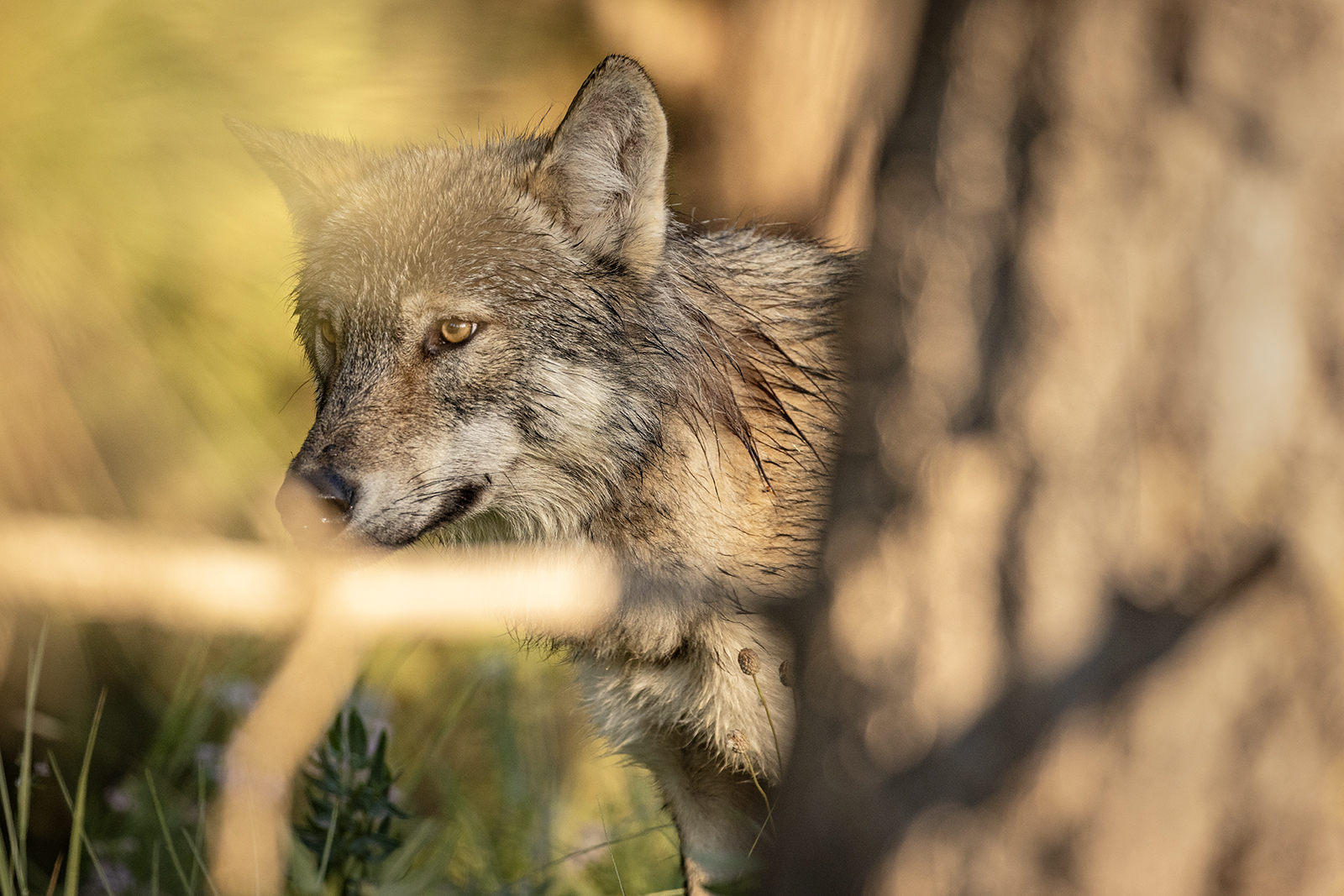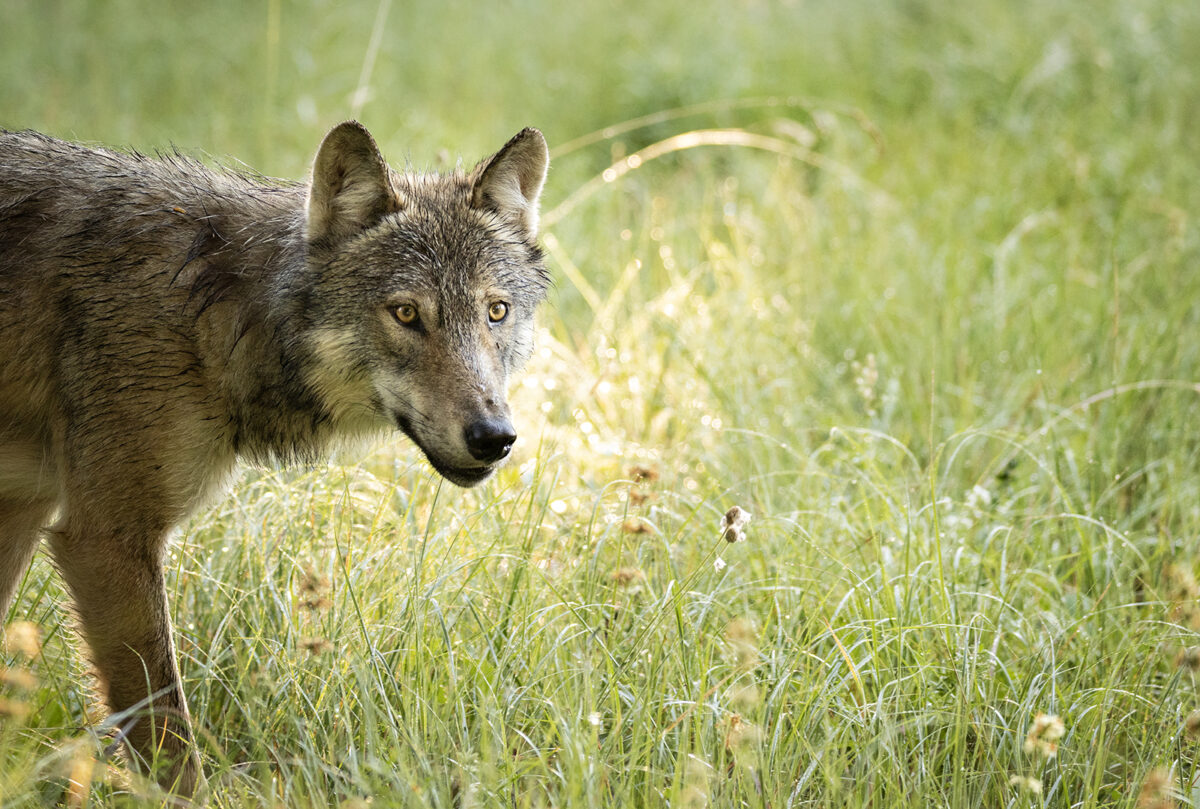Wildlife Officials Say Montana’s New Wolf Management Plan Sets a ‘Conservative Benchmark’ for Conservation
Facing a legislative mandate to reduce the wolf population, state wildlife managers describe crafting a balanced plan that accounts for competing interests. Republican lawmakers, pushing a slate of anti-wolf bills, say the plan isn’t tough enough.
By Tristan Scott
In arriving at Montana’s new gray wolf management plan, state wildlife officials describe walking a prudent path as they followed a 2021 legislative mandate to dramatically reduce the wolf population while adhering to the contours of a scientific formula that not only supports long-term conservation, but also guards against a return to federal control under the Endangered Species Act (ESA).
The 2025 Montana Gray Wolf Conservation and Management Plan was formally completed on March 26, marking its first update in 22 years and signaling a long-awaited revision to the strategy since federal protections for wolves in Montana were removed in 2011, with Montana Fish, Wildlife and Parks (FWP) assuming management authority. The final plan sets a minimum baseline of 450 wolves, which the agency said ensures 15 breeding pairs, a threshold set by the U.S. Fish and Wildlife Service (FWS) in its final delisting rule to ensure the population never falls below recovery goals.
But for a species as politically and socially polarizing as wolves, it’s not surprising that the durability of the plan, and the resilience of the species, is already being tested as lawmakers push another package of anti-wolf bills through the legislature. The three bills that have sustained the most momentum all seek to expand opportunities for hunters to harvest wolves, including by removing bag limits and creating an open hunting season. Proponents of the initiatives said other efforts to drive down the abundance of wolves, such as night hunting and using bait and neck snares, have fallen short of their purpose.
Introduced by Rep. Shannon Maness, R-Dillon, House Bill 176 would remove bag limits with the aim of cleaving Montana’s wolf population by more than half, reducing it from roughly 1,100 animals to 450, which is Montana’s minimum number of wolves needed to ensure continued state management. The measure, which failed during third reading March 31 on a 23-27 vote, would have required an unlimited wolf hunting quota when the wolf population is at or above 450.
The proposed reduction is so aggressive that one lawmaker with a demonstrated appetite for anti-wolf legislation recently opposed it, describing the initiative as overkill and worrying that it might place wolves back under federal management.
Sen. Bruce “Butch” Gillespie, R-Ethridge, issued that caveat during a March 28 Senate floor session to consider HB 176, as well as two other wolf-related bills: HB 258, which would extend the state’s wolf hunting season by three months, until mid-June, when critics of the measure say wolves may be denning with pups; and HB 259, which would allow the use of thermal and infrared scopes to accommodate night hunting.
“For those of you that have put up with me for the last three sessions, you’re going to think I’m going bonkers today,” Gillespie said. “But there are three wolf bills here … the second two we really, really like. But from a livestock part, we do worry — our associations do — that if we overdo this thing there’s a great likelihood that the wolves will get back on the endangered species list.”

The Trump administration removed Endangered Species Act protections for wolves across the lower 48 states just before Trump left office after his first term in 2020. A federal judge in 2022 restored those protections across 45 states, but left wolf management to state officials in others, including Montana.
Acknowledging that it’s unlikely the current administration would restore federal protections to wolves, some lawmakers still warned that dismantling the state’s proven framework to effectively manage and sustain a viable wolf population could eventually lead to a reappraisal by FWS.
“When Fish and Wildlife Service considered delisting, they looked at state management. And if a state waters down its regulatory language too much, you’re in trouble,” Sen. Pat Flowers, D-Missoula, said during the floor session.
Flowers also questioned why — given the documented decline in livestock losses, the stabilization of the wolf population and the rebounding deer and elk numbers — the GOP-led Montana Legislature remains so dead set on approving another batch of initiatives to kill more wolves?

Since 2009, the livestock depredation reports to FWP have declined from a high of 233 in 2009 to about 100 or less today. And in 2015, the U.S. Department of Agriculture reported that a mere 0.37% of cattle and 1.31% of calf losses were attributed to wolves. Meanwhile, social tolerance for wolves is growing, as evidenced by a report from the University of Montana’s Institute of Tourism and Recreation Research, which estimated that $82.7 million in annual visitor spending in the northern Rockies is attributed to ecotourism surrounding wolves.
“I had the unique opportunity to live through the heat of the wolf wars in the early 2000s,” Flowers told lawmakers last week. “The question on my mind is, if we’ve got a pretty stable set of circumstances here and we’ve come out of this period that was incredibly divisive and the public had such a hard time accepting them, why do we want to flip the table and start all over?”
The general decrease in livestock depredations may be a result of several factors, according to FWP, including more aggressive and rapid wolf control in response to depredations, the effects of public hunting and the proliferation of non-lethal depredation deterrents, such as the use of fladry (brightly colored flags suspended from fencing cordage) to ward wolves away from livestock calving pastures.
Still, proponents of the wolf-hunting initiatives say FWP is too submissive in providing direction to the Fish and Wildlife Commission, which sets the hunting and trapping seasons.
“Fish, Wildlife and Parks doesn’t seem to be listening, so that’s why we have wolf bill, after wolf bill, after wolf bill,” Sen. Greg Hertz, R-Polson, said during the Senate floor session.
Sen. Vince Ricci, R-Billings, said the state agency’s resistance to more aggressive policies has put lawmakers in a perennial dilemma to enact harsher measures aimed at curbing wolf abundance.
“This is hard for all of us but these bills are kind of forced on us because of the lack of support from the Department of Fish, Wildlife and Parks,” Ricci said. “They are not bringing us any alternatives.”

Although Hertz conceded that livestock depredation has gone down, he said the very presence of wolves on the landscape can lead to stress-induced losses for producers.
“Livestock depredation, yes, it’s kind of stabilized or gone down, but there’s also more to [raising] livestock. Even though they’re not killing them, when you have wolves running around your cattle or sheep, it does bother them and it can create, you know, less breeding,” Hertz said.
A 2014 study found no evidence that wolf presence had any detrimental effects on calf weights, according to FWP. Rather, non-wolf factors such as climate and husbandry practices figured more prominently into calf survival.
Testimony on behalf of the suite of bills targeting wolves also cited depressed elk numbers and diminishing rates of hunter success in wolf-heavy areas of the state, including northwest Montana.
Although wildlife biologists have acknowledged that wolves have an impact on deer and elk populations, especially in predator-rich environments like northwest Montana, where wolf population densities are estimated to be highest, they note that there are other factors at play on the landscape. For example, while approximately 480 wolves roam the land managed by FWP in Region 1, an area spanning northwest Montana that includes the Flathead Valley, about 1,300 mountain lions are hunting the same landscape.
Still, Hertz urged lawmakers to pass all three measures, assuring them that wolves can withstand the pressure.
“I’m not sure we’ll ever get back to a population of 550 wolves even if we pass unlimited hunting, anything you want to do, 365 days of the year,” he said. “I don’t thing we can get there. Wolves are very hard to hunt anymore. When they see you, they are gone.”

Gray wolves are still listed under the ESA as endangered in 44 states, and are considered threatened in Minnesota; however, in Montana, Idaho, Wyoming, and portions of eastern Oregon and Washington, the wolves are managed under state jurisdiction, with their respective legislatures passing laws allowing wolf harvests, while setting quotas and regulations to manage the populations.
In Montana, FWP’s new conservation and management plan was released in draft form in 2023, touching off a groundswell of interest and prompting the agency to reopen the public comment period last year “to ensure Montana counties, Tribes, and state and federal agencies have a change for input,” according to the agency, which said it reviewed 24,750 comments.
Under the plan, the state will continue to base wolf population estimates on the Integrated Patch Occupancy Modeling method, or iPOM. The final plan also reflects the current depredation prevention and response program.
“Wolf management discussions continue to draw a lot of attention from people in Montana and around the world,” FWP Director Christy Clark said in a prepared statement announcing the plan’s completion. “The 2025 Wolf Plan will ensure those conversations can be grounded in current science and the research FWP is doing every day.”

Molly Parks, FWP’s statewide carnivore coordinator, said the final plan balances a tension between the legislative mandate to reduce the wolf population, and opposition from wolf-advocacy groups who say the state is overestimating its wolf population and recklessly assenting to a radical wolf-hunting agenda.
“Wolves are a controversial topic which leads to these competing management objectives,” Parks said. “On one end you have folks who want a healthy population and who are concerned we are overestimating and potentially over-harvesting the resource. On the other hand, there are folks who think we have too many wolves, and that they are having an impact on ungulate populations and livestock depredation. We are trying to take into account all of those perspectives and balance those needs.”
Parks also defended the integrated patch occupancy model [iPOM] as a scientifically peer-reviewed and cost-effective means of monitoring wolves and documenting their distribution. Although field monitoring was practical two decades ago when the wolf population was still recovering, it’s no longer feasible. The iPOM method uses annual hunter surveys, known wolf pack locations, habitat monitoring, and estimates of wolf territory and pack size based on field data to estimate wolf distribution and population size.
“Some folks are concerned that we are overestimating the population and that if we dip down below 450, we might be dipping even further,” Parks said. “That is absolutely the last thing we want. What we do want is a healthy, viable and connected population. And based on the biology of wolves and what we have seen in Montana we feel this plan helps us manage wolves but ensure the long-term existence of wolves on the landscape.”
Should the wolf population decline to the point where it approaches 450 wolves, FWP would recommend shifting strategies to the state Fish and Wildlife Commission. While FWP does not have a specific population objective, the wolf population may fluctuate anywhere within the estimated population size identified during the 2021 Legislative Session, according to the plan, “with the intent to reduce the wolf population in this state to a sustainable level not less than a population estimate of 450 individuals depending on what is considered biologically and socio-politically sustainable. FWP does not have specific objectives for the distribution of wolves.”
Some conservation groups, however, say FWP has failed to strike a balance and is managing the wolf population “from the floor,” maintaining just enough of a wolf presence to keep the species under state management authority. Regardless of the agency’s intent, they say, the new plan will lead to a significant reduction in the wolf population as lawmakers continue to push a radical agenda.
Lizzy Pennock, the carnivore coexistence advocate for WildEarth Guardians, said the plan’s “benchmark” of 450 wolves as the minimum threshold has been repeatedly misconstrued by lawmakers as a mandate to adopt more liberal methods of wolf hunting, which she said could cause significant harm to the population.
“The legislature makes the laws and, hierarchically, it controls the agency,” Pennock said. “And these laws were never about management and science, they are about killing as many wolves as possible. I don’t think that is the strategy that FWP is taking, even though we frequently disagree with FWP, but it is the strategy as interpreted by the House of Representatives introducing these laws.”
Pennock said it’s notable that FWP officials have testified against the measures during committee hearings, and she gave wildlife managers credit for their effort to integrate public comment into the plan.
“I think it speaks volumes that FWP has been testifying against most of the wolf legislation we have seen this session, and that even livestock groups are not testifying in favor of these bills,” Pennock said. “That goes to show that legislators have gotten so extreme that they are kind of on their own island.”
During previous legislative sessions, FWP administrators had been notably absent during committee hearings, other than to offer insight as informational witnesses. Asked whether FWP’s testimony opposing several wolf-hunting initiatives this session is the result of a specific policy change, agency spokesperson Greg Lemon said the department responds to proposed legislation on a case-by-case basis.
“We feel like our role is to use our expertise to help inform the legislative process. We start our consideration on a piece of legislation from the position of being informational in our testimony,” Lemon stated in an email. “Supporting or opposing legislation is a decision we take seriously and is only done after careful and thorough deliberation.”
Lemon said the new wolf management plan allows FWP to be adaptive and flexible as the legislature prescribes new laws, while remaining confident that it safeguards the species and provides an enduring blueprint for Montana’s policymakers.
“Our job is to manage the wildlife resources in the state. As part of that role, we put forth a management plan that has a lot of public input and consideration on how best to manage those resources,” Lemon said. “It was important that this plan reflected the science and our management experiences to date. As an agency, that’s our role. We won’t craft management plans that direct commission or legislative decisions. This plan can be a tool for those decisions.”
This story was updated to reflect the failure of House Bill 176, which would have required unlimited wolf hunting quotas until Montana’s population is below 450 wolves. The measure failed on third reading during a March 31 Senate floor session on a 23-27 vote. House Bill 258 to extend the wolf hunting season and House Bill 259 to allow thermal and infrared scopes both passed on third reading.